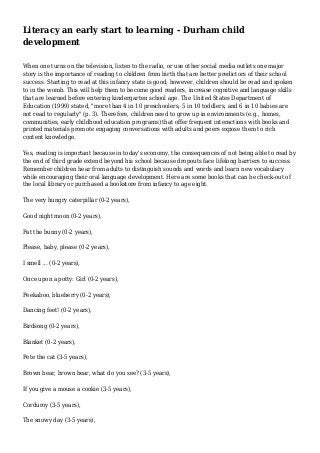
Literacy an early start to learning - Durham child development
- 1. Literacy an early start to learning - Durham child development When one turns on the television, listen to the radio, or use other social media outlets one major story is the importance of reading to children from birth that are better predictors of their school success. Starting to read at this infancy state is good; however, children should be read and spoken to in the womb. This will help them to become good readers, increase cognitive and language skills that are learned before entering kindergarten school age. The United States Department of Education (1999) stated, "more than 4 in 10 preschoolers, 5 in 10 toddlers, and 6 in 10 babies are not read to regularly" (p. 3). Therefore, children need to grow up in environments (e.g., homes, communities, early childhood education programs) that offer frequent interactions with books and printed materials promote engaging conversations with adults and peers expose them to rich content knowledge. Yes, reading is important because in today's economy, the consequences of not being able to read by the end of third grade extend beyond his school because dropouts face lifelong barriers to success. Remember children hear from adults to distinguish sounds and words and learn new vocabulary while encouraging their oral language development. Here are some books that can be check-out of the local library or purchased a bookstore from infancy to age eight. The very hungry caterpillar (0-2 years), Good night moon (0-2 years), Pat the bunny (0-2 years), Please, baby, please (0-2 years), I smell ... (0-2 years), Once upon a potty: Girl (0-2 years), Peekaboo, blueberry (0-2 years), Dancing feet! (0-2 years), Birdsong (0-2 years), Blanket (0-2 years), Pete the cat (3-5 years), Brown bear, brown bear, what do you see? (3-5 years), If you give a mouse a cookie (3-5 years), Corduroy (3-5 years), The snowy day (3-5 years),
- 2. Rhyming dust bunnies (3-5 years), The napping house (3-5 years), Caps for sale (3-5 years), From head to toe (3-5 years), Llama llama red pajama (3-5 years), The twits (6-8 years, Mr. Brown can moo! Can you! (6-8 years), Five on a treasure island (6-8 years), The mystery of the silver spider (6-8 years), Knuffle bunny: A cautionary tale (6-8 years), A wrinkle in time (6-8 years), Ramona and her father (6-8 years), The tale of Despereaux (6-8 years), Don't let the pigeon stay up late (6-8 years), and Charlotte's web (6-8 years). Keep in mind that only one-third of America's fourth-graders are reading proficiently. Children who are not reading on grade level by this point will only fall farther behind their peers, and they are at much higher risk of dropping out of high school. It has been projected that two-thirds of jobs in the United States workforce soon requiring some level of postsecondary education. Source: U.S. Department of Education (1999). Start early, finish strong: How to help every child become a reader. Washington, DC: Author.